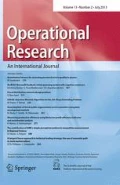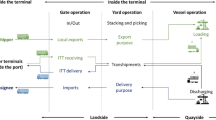Abstract
In this paper we propose a fuzzy neural network prediction approach based on metaheuristics for container flow forecasting. The approach uses fuzzy if–then rules for selection between two different heuristics for developing neural network architecture, simulated annealing and genetic algorithm, respectively. These non-parametric models are compared with traditional parametric ARIMA technique. Time series composed from monthly container traffic observations for Port of Barcelona are used for model developing and testing. Models are compared based on the most important criteria for performance evaluation and for each of the data sets (total container traffic, loaded, unloaded, transit and empty) the appropriate model is selected.




Similar content being viewed by others
References
Abdalla OA, Osman A, AlMurtadha YM (2014) Optimizing the multilayer feed-forward aritificial neural networks architecture and training parameters using genetic algorithms. Int J Comput Appl 96(10):42–48
Agatonovic KS, Beresford R (2000) Basic concepts of artificial neural network (ANN) modeling and its application in pharmaceutical research. J Pharm Biomed Anal 22:717–727
Arifovic J, Gencay R (2001) Using genetic algorithms to select architecture of feedforward artificial neural network. Physica 289:574–594
Atsalakis G, Valavanis K (2008) Surveying stock market forecasting techniques—Part II: soft computing methods. Expert Syst Appl 36:5932–5941
Atsalakis G, Valavanis K (2009) Forecasting stock market short-term trends using a neuro-fuzzy based methodology. Expert Syst Appl 36:10696–10707
Atsalakis G, Dimitrakakis E, Zopounidis C (2011) Elliot wave theory and neuro-fuzzy systems, in stock market prediction. Expert Syst Appl 38(8):9196–9206
Blanco A, Delgado M, Pegalajar MC (2000) A genetic algorithm to obtain the optimal recurrent neural network. Int J Approx Reason 23:67–83
Box GEP, Jenkins GM (1976) Time series analysis: forecasting and control. Holden Day, San Francisco
Box GE, Jenkins GM, Reinsel GC (2008) Time series analysis, forecasting and control. Wiley, New Jersey
Chen SH, Chen JN (2010) Forecasting container throughputs at ports using genetic programming. Expert Syst Appl 37(3):2054–2058
Chen C, Liu LM (1993) Joint estimation of model parameters and outlier effects in time series. J Am Stat Assoc 88(421):284–297
Chibante R (2010) Simulated annealing theory with applications. Sciyo, Croatia
Chou CC (2004) A study on forecasting the container volume of international ports in Taiwan area. Ph.D. dissertation, Department of Shipping and Transportation Management, National Taiwan Ocean University
Chou CC, Chu CW, Liang GS (2008) A modified regression model for forecasting the volumes of Taiwan’s import containers. Math Comput Model 47(9–10):797–807
Denai MA, Palis F, Zeghbib A (2007) Modeling and control of non-linear systems using soft computing techniques. Appl Soft Comput 7(3):728–738
Diaz R, Talley W, Tulpule M (2011) Forecasting empty container volumes. Asian J Shipp Logist 27(2):217–236
Donate JP, Li X, Sanchez GG, Miguel ASD (2011) Time series forecasting by evolving artificial neural networks with genetic algorithms, differential evolution and estimation of distribution algorithm. Neural Comput Appl 22(1):11–20
Fung MK (2002) Forecasting Hong Kong’s container throughput: an error-correction model. J Forecast 21(1):69–80
Gao Y, Luo M, Zou G (2016) Forecasting with model selection or model averaging: a case study for monthly container port throughput. Transportmetrica A Transp Sci 12(4):366–384
Ghasemiyeh R, Moghdani R, Sana SS (2017) A hybrid artificial neural network with metaheuristic algorithms for predicting stock price. Cybern Syst 48:365–392
Ghosh R, Ghosh M, Yearwood J, Bagirov A (2005) Comparative analysis of genetic algorithm, simulated annealing and cutting angle method for artificial neural networks, pp 62–70. In: Machine learning and data mining in pattern recognition: proceedings of the 4th international conference, MLDM 2005, Germany
Glisovic N, Milenkovic M, Bojovic N, Svadlenka L, Avramovic Z (2015) A hybrid model for forecasting the volume of passenger flows on Serbian railways. Oper Res Int J 16(2):271–285
Gosasang V, Chandraprakaikul W, Kiattisin S (2011) A comparison of traditional and neural networks forecasting techniques for container throughput at Bangkok port. Asian J Shipp Logist 27(3):463–482
Herrera F, Martınez L (2000) A 2-tuple fuzzy linguistic representation model for computing with words. IEEE Trans Fuzzy Syst 8(6):746–752
Huang A, Lai KK, Li Y, Wang S (2015) Forecasting container throughput of Qingdao port with a hybrid model. J Syst Sci Complex 28(1):105–121
Hui ECM, Seabrooke W, Wong GKC (2004) Forecasting cargo throughput for the Port of Hong Kong: error correction model approach. J Urban Plan Dev 130(4):195–203
Hui ECM, Ng MH, Xu JJ, Yip TL (2010) The cargo throughput response to factor cost differentials—an analysis for the port of Hong Kong. Transportmetrica 6(4):235–248
Ishibuchi H, Kwon K, Tanaka H (1993) Implementation of fuzzy IF-THEN rules by fuzzy neural networks with fuzzy weights, In: Proceedings of the EUFIT’93 conference, Aachen, Germany, pp 209–215
Ishibuchi H, Fujioka R, Tanaka H (1993b) Neural networks that learn from fuzzy IF-THEN rules. IEEE Trans Fuzzy Syst 1:85–97
Ishibuchi H, Tanaka H, Okada H (1993) Fuzzy neural networks with fuzzy weights and fuzzy biases, In: Proceedings of the IEEE international conference on neural networks, San Francisco, pp 447–452
Ishibuchi H, Tanaka H, Okada H (1994) Interpolation of fuzzy IF THEN rules by neural networks. Int J Approx Reason 10:3–27
Kaviani M, MirRokni SM (2017) Applying genetic algorithm in architecture and neural network training. Int J Comput Sci Netw Secur 17(6):118–124
Kosko B (1992) Neural networks and fuzzy systems. Prentice-Hall, Englewood Cliffs
Lam WHK, Ng PLP, Seabrooke W, Hui ECM (2004) Forecasts and reliability analysis of port cargo throughput in Hong Kong. J Urban Plan Dev 130(3):133–144
Lam W, Tang Y, Chan K, Tam M (2006) Short-term hourly traffic forecasts using Hong Kong annual traffic census. Transportation 33(3):291–310
Lee LW, Wang HF, Chen SM (2008) Temperature prediction & TAIFEX forecasting based on high-order fuzzy logical relationships & genetic simulated annealing techniques. Expert Syst Appl 34(1):328–336
Lee SY, Lim H, Kim HJ (2017) Forecasting container port volume: implications for dredging. Marit Econ Logist 19(2):296–314
Liao GC, Tsao TP (2006) Application of a fuzzy neural network combined with a chaos genetic algorithm and simulated annealing to short-term load forecasting. IEEE Trans Evol Comput 10(3):330–340
Lingras P, Sharma SC, Osborne P, Kalyar I (2000) Traffic volume time-series analysis according to the type of road use. Comput Aided Civ Infrastruct Eng 15(5):365–373
De Livera AM, Hyndman RJ, Snyder RD (2010) Forecasting time series with complex seasonal patterns using exponential smoothing. J Am Sta Assoc 106:1513–1527
Liu Z, Ji L, Ye Y, Geng Z (2007) Combined forecast method of port container throughput based on RBF neural network. J Tongji Univ (Nat Sci) 35(5):739
MacKay JCD (2003) Information theory, inference and learning algorithms. Cambridge University Press, Cambridge
Michalewicz Z, Fogel DB (2000) How to solve it: modern heuristics. Springer, Berlin
Milenkovic M, Svadlenka L, Melichar V, Bojovic N, Avramovic Z (2016) SARIMA modelling approach for railway passenger flow forecasting. Transport 33(5):1113–1120
Mo L, Xie L, Jiang X, Teng G, Xu L, Xiao J (2018) GMDH-based hybrid model for container throughput forecasting: selective combination forecasting in nonlinear subseries. Appl Soft Comput 62:478–490
Moscoso-Lopez JA, Turias IJ, Jimenez-Cone MJ, Ruiz-Aguilar JJ, Cerban M (2016) Short-term forecasting of intermodal freight using ANNs and SVR: case of the Port of Algeciras Bay. Transp Res Procedia 18:108–114
Niu M, Hu Y, Sun S, Liu Y (2018) A novel hybrid decomposition-ensemble model based on VMD and HGWO for container throughput forecasting. Appl Math Model 57:163–178
Osborn DR, Chui APL, Smith JP, Birchenhall CR (1988) Seasonality and the order of integration for consumption. Oxford Bull Econ Stat 50:361–377
Pang G, Gebka B (2017) Forecasting container throughput using aggregate or terminal-specific data. The case of Tanjung Priok Port, Indonesia. Int J Prod Res 55:2454–2469
Peng WY, Chu CW (2009) A comparison of univariate methods for forecasting container throughput volumes. Math Comput Model 50(7–8):1045–1057
Port of Barcelona (2017) Statistical reports 2010–2016. http://www.portdebarcelona.cat/en/web/autoritat-portuaria/estadisticas. Accessed 16 Jan 2017
Ruiz-Aguilar JJ, Turias IJ, Jiménez-Come MJ (2014) Hybrid approaches based on SARIMA and artificial neural networks for inspection time series forecasting. Transp Res Part E Logist Transp Rev 67:1–13
Schulze PM, Prinz A (2009) Forecasting container transshipment in Germany. Appl Econ 41(22):2809–2815
Seabrooke W, Lam WHK, Wong GKC (2003) Forecasting cargo growth and regional role of the port of Hong Kong. Cities 20(1):51–64
Sexton RS, Dorsey RE, Johnson JD (1999) Optimization of neural networks: a comparative analysis of the genetic algorithm and simulated annealing. Eur J Oper Res 114:589–601
Smith BL, Williams BM, Keith Oswald R (2002) Comparison of parametric and nonparametric models for traffic flow forecasting. Transp Res Part C 10(4):303–321
Soares S, Antunes CH, Araujo R (2013) Comparison of genetic algorithm and simulated annealing for automatic neural network ensemble development. Neurocomputing 119:498–521
Suhartono S (2011) Time series forecasting by using seasonal autoregressive integrated moving average: subset: multiplicative or additive model. J Math Stat 7(1):20–27
Szu H, Hartley R (1987) Fast simulated annealing. Phys Lett A 122(3–4):157–162
Taskaya-Temizel T, Casey MC (2005) A comparative study of autoregressive neural network hybrids. Neural Netw 18(5–6):781–789
Tsai FM, Huang LJW (2015) Using artificial neural networks to predict container flows between the major ports of Asia. Int J Prod Res 55(17):5001–5010
Twrdy E, Batista M (2016) Modeling of container throughput in Northern Adriatic ports over the period 1990–2013. J Transp Geogr 52:131–142
Vlahogianni EI, Golia JC, Karlaftis MG (2004) Short-term traffic forecasting: overview of objectives and methods. Transport Rev 24(5):533–557
Vlahogianni EI, Karlaftis MG, Golias JC (2005) Optimized and meta-optimized neural networks for short-term traffic flow prediction: a genetic approach. Transp Res Part C Emerg Technol 13(3):211–234
Wei Y, Chen MC (2012) Forecasting the short-term metro passenger flow with empirical mode decomposition and neural networks. Transp Res Part C 21(1):148–162
Wu TH, Chang CC, Chung SHA (2008) Simulated annealing algorithm for manufacturing cell formation problems. Expert Syst Appl 34(3):1609–1617
Xiao J, Xiao Y, Fu J, Lai KK (2014) A transfer forecasting model for container throughput guided by discrete PSO. J Syst Sci Complex 27(1):181–192
Xie G, Wang S, Zhao Y, Lai KK (2013) Hybrid approaches based on LSSVR model for container throughput forecasting: a comparative study. Appl Soft Comput 13(5):2232–2241
Xie G, Zhang N, Wang S (2017) Data characteristic analysis and model selection for container throughput forecasting within a decomposition-ensemble methodology. Transp Res Part E 108:160–178
Yan W (2012) Toward automatic time-series forecasting using neural networks. IEEE Trans Neural Netw Learn Syst 23(7):1028–1039
Zadeh LA (1965) Fuzzy set. Inf Control 8(3):338–353
Zhang PL, Cui Y (2011) Research on combination forecast of port container throughput based on Elman neural network. In: Proceedings of the 3rd international conference on communication software and networks (ICCSN), pp 567–570
Zhang G, Patuwo BE, Hu MY (1998) Forecasting with artificial neural networks: the state of the art. Int J Forecast 14:35–62
Acknowledgements
Authors would like to express their gratitude to Prof. Nikolaos Fragkiskos Matsatsinis (Editor) and two anonymous reviewers for their very useful suggestions which significantly improved this paper. The paper is supported by the Serbian Ministry of Education and Science (Project III44006 and I36022) and the project “Clusters 2.0: Open network of hyper connected logistics clusters towards Physical Internet” which has received funding from the European Union’s Horizon 2020 research and innovation programme under Grant Agreement No. 723265.
Author information
Authors and Affiliations
Corresponding author
Additional information
Publisher's Note
Springer Nature remains neutral with regard to jurisdictional claims in published maps and institutional affiliations.
Rights and permissions
About this article
Cite this article
Milenković, M., Milosavljevic, N., Bojović, N. et al. Container flow forecasting through neural networks based on metaheuristics. Oper Res Int J 21, 965–997 (2021). https://doi.org/10.1007/s12351-019-00477-1
Received:
Revised:
Accepted:
Published:
Issue Date:
DOI: https://doi.org/10.1007/s12351-019-00477-1




